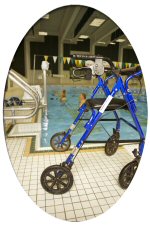


Creating Change >
Physical Environment Level: Physical Access
Life shouldn’t be an obstacle course.
And for most of us, it isn’t. But if you think of accessibility from the perspective of a person with limited mobility, potential obstacles are everywhere.
Focus groups participants—especially older adults and people with disabilities—identified numerous obstacles that make it difficult for them to participate in physical activities.
Many of these obstacles make it difficult to access buildings—including recreation facilities such as swimming pools, arenas, gyms, and indoor tracks. For example, buildings that can only be accessed by steps, change rooms with narrow doors, and swimming pools witho ut ramps can make it difficult—if not impossible—for people with limited mobility to use a facility. Outdoor activity can also be limited if playgrounds, parks, paths, campgrounds, and community gardens are inaccessible.
ut ramps can make it difficult—if not impossible—for people with limited mobility to use a facility. Outdoor activity can also be limited if playgrounds, parks, paths, campgrounds, and community gardens are inaccessible.
Ensuring facilities and outdoor spaces are accessible can be a tall order, especially if you’re trying to make an older building more accessible or if your organization has a limited budget. But this doesn’t mean the issue should be ignored. If budget is a concern, you can take small steps to address this issue. Every change—no matter how small—is a step toward improved accessibility.
I think most community-based organizations are geared towards people who are mobile. And . . . they just don’t think about people that have mobility issues. Even in the senior centres, where you’d expect them to be there, they haven’t got a clue.
Focus group participant with a disability
I hate the machines where somebody has to crank you down into the water and crank you out—you always need help. At Grant MacEwan they have a ramp to take you down into the water.
Focus group participant with a disability
Enhancing Physical Access: An Ecological Approach
How can you best support persons with limited mobility in their attempts to be physically active? To create a physically accessible environment, use strategies that incorporate the various levels of an ecological model:
Want to learn more about this topic? Click here for useful online materials.
- The Individual
- The Social Environment
- The Physical Environment
- Policies and Regulations
Strategies for enhancing physical access
Quick links in Creating Change sectionIndividual Level Social Environment Level Physical Environment Level
|